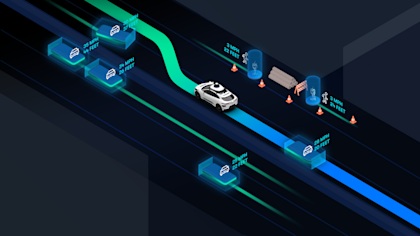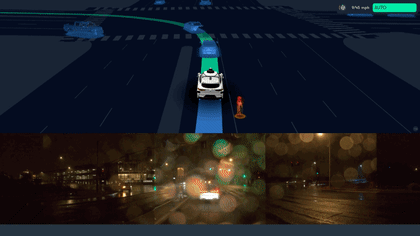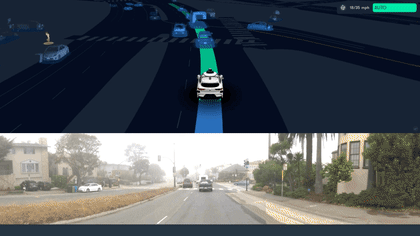August 4, 2023
The Waymo Driver's Rapid Learning Curve


Imagine if you could automatically learn from the driving experiences of others on the road, absorbing knowledge about all the complicated scenarios they've encountered. The Waymo Driver covers tens of thousands of miles — equivalent to a lifetime of human driving experience — in a matter of days; in simulation, it does so in minutes. But driving is a social and complex task, so it’s not just about accumulating miles, but learning from each one. Our Driver has a unique ability to learn from road events across the entire fleet, advancing its capabilities at incredible speeds. This rapid pace of learning is one of the key factors that has enabled our recent expansion across multiple major U.S. cities. Here’s a glimpse of some technological advancements that have directly contributed to our progress, as well as areas where we continue to accelerate and improve.
Over the years, we’ve listened to our riders’ feedback, actively engaged with local communities, gathered valuable insights from human drivers, and continuously learned from our own experience. To effectively utilize all this knowledge to advance our technology, we’re using cutting-edge ML as the backbone of our Driver. In particular, it allows us to detect and recognize all kinds of objects with high accuracy in all conditions, understand and interpret complex object and scene semantics, and make our driving smooth and human-like.
Being ML-primary, the tech behind the Waymo Driver, also adapts to new challenges and learns from experience fast. That, combined with robust training and evaluation infrastructure, allows us to rapidly and regularly enhance the Waymo Driver’s capabilities. Our software updates come out like clockwork. Each update undergoes rigorous testing and unlocks new features and performance improvements for the Driver across our entire fleet — from parking and multi-point turn maneuvers to handling heavier levels of fog and rain — as if a driving lesson for one teaches the whole fleet. This allows us to safely deploy not just individual cars but our entire fleet in increasingly more complex driving environments and expand to new cities faster.
Some of our key areas of focus include:
Weather. Rain or shine, Waymo One riders can enjoy fully autonomous trips in a range of weather conditions. During this past winter season in California with its record rain, high winds, and thunderstorms, we were able to maintain 99.4% fleet uptime — an exceptional level of service reliability, and unmatched in the AV industry, that wouldn’t be possible even a year ago. We also got valuable learnings navigating many new challenges during this historic weather, such as multiple broken traffic lights at San Francisco’s major intersections, that have already helped us further improve the Waymo Driver’s performance. And with our latest software release, our Driver is now equipped to handle even heavier levels of fog than before — right in time for San Francisco’s fog season.

Driving in rain in Phoenix, AZ last week
Construction. As we operate in some of the largest and densest cities in the U.S. with the sheer amount of construction taking place, we drive around active construction zones day and night. Responding to handheld signs, maneuvering around construction cones that come in all colors and sizes, and changing lanes for road work ahead even if the proper signage is missing — these are just some of the many challenges for which we meticulously prepare the Waymo Driver. And while our work is not done, we’re seeing strong performance and rapid ongoing improvements around construction sites.
Emergency vehicles. Navigating around and yielding to active emergency vehicles, like police vehicles, fire engines, and ambulances, can be challenging for both autonomous and human drivers. The Waymo Driver uses its advanced sensor suite and cutting-edge perception system to detect and localize emergency vehicle sirens and flashing lights and is prepared to slow down and yield. Such interactions are incredibly common: in fact, the Waymo Driver encounters active emergency vehicles approximately once per 100 miles, which equates to hundreds of encounters a day. We also train and work closely with many public safety officials and first responders on how to safely respond and interact with our vehicles when that is required. First responders have a direct line of communication with Waymo’s team and can even transition the vehicle to a manual configuration to move it quickly if needed — a feature that we built in response to a request from first responders several years ago.
Naturally, sometimes we encounter novel situations on the road, which our Driver is designed to learn from and handle with safety in mind. Some of these situations may require our vehicle to slow down or stop if that’s assessed to be the safest course of action. Sharing the road with cars that have no one behind the wheel is a new experience for many, so it’s understandable that some of these events capture attention.
The vast majority of such events when our car comes to a stop—or would have come to a stop in the past—are now resolved by the Waymo Driver, without assistance. To help resolve such situations more efficiently and make the Waymo Driver’s actions more predictable, we recently introduced new external audio alerts — for example, to inform pedestrians around the stopped vehicle that we’re working to get it moving, or that they’re in a path that we’re intending to take when safe.
Each such scenario is carefully evaluated by the team and helps further advance our system. Although the continuous progress that we make may not always be readily apparent, sometimes a single software update can resolve what was a challenge just a couple of weeks ago. For example, after experiencing a temporary issue due to very heavy fog in San Francisco’s Balboa Terrace earlier this year, we evaluated the scenario using a newer version of software released shortly after the event. Our tests confirmed that the latest release ensured the Waymo Driver would be able to seamlessly navigate through that level of fog.

Driving in San Francisco’s fog
We are always looking for ways to make our service better and carefully listen to our riders and the communities we drive in, including their first responders. The feedback we receive helps us identify more areas where we can make improvements. We’ve built our service with the needs of riders and local communities in mind and can’t wait to welcome more people to our Waymo One service soon.

